When it comes to online trading, many people mistakenly refer to Forex by distinguishing it for example from binary options or other financial instruments … what are we talking about in reality?
Introduction
Indeed there is a lot of confusion about the term Forex and financial instruments, and it is very common to also see blogs that deal with these topics say things like “binary options unlike Forex platforms …”.
In reality, FOREX defines an asset rather than a financial instrument since it indicates the speculation on the exchange rates of foreign currencies. And it is an asset that is found in all binary options platforms, so it does not make much sense to speak of “Forex platforms” as opposed to those for options, since the options are a financial instrument and not an asset (which can be stocks, indices, commodities and currencies / forex).

So what happens on online trading platforms that are not binary options? Basically all those platforms that made Forex very popular in the past years and spread online trading in the world?
They are all platforms based on a derivative instrument called CFD (Contract For Difference). Binary options are also a derivative tool. To understand briefly and effectively what a derivative instrument is without going into financial matters, let’s say that these are tools that allow investing without having to own the asset.
On the online trading platforms, whether CFD or binary options we can invest a few euros speculating on shares of companies that are listed hundreds of dollars for a single share. This is possible because in reality we do not buy or sell that asset, but simply fractions of its value transformed by brokers into contracts that can be purchased through online platforms.
CFD contracts depend on brokers to brokers, even if they all generally have common characteristics, with online brokers the variations depend mainly on the size (and therefore the value of contracts) and on the leverage, ie how much it can cost to invest and how much it can be obtained from the investment.
How CFDs work

To explain how CFDs work in operation, we say that we are already on an online trading platform. We follow the stock market with interest and we want to try to make a speculative investment with Facebook actions.
As we have already said, there is no need with CFDs to buy the whole action but only a part (we decide how many contracts and how much to spend based on the options of the platform). Once bought, we opened the position.
The open position means that we will begin a cash flow exchange between us and our broker based precisely on price fluctuations relative to the value at the time of purchase and our investment. In fact, we can open a position by deciding whether our investment is on the upside (buy the asset contracts and then resell them at a higher price) or down (we sell the asset with the commitment to buy it back at the current price in the future , so if the price drops in the meantime we will earn from the price difference).
With CFDs every open position is linked to our trading account, which means we are not only responsible for the money we spend to buy those contracts, but that as long as that position remains open all our trading capital is at risk.
As long as we do not close the position, even if the investment is going well for us, we will not pocket the profit, as if things go wrong we will continue to lose money until we close.
Knowing when to close is important: if we close too quickly a position that is going well for us, we risk stopping when things could go better, as well as closing too late can reduce us on the pavement. The open positions are renegotiated each night automatically until no one closes them.
The platforms however help us, and thanks to the orders of “stop loss” we can close the positions automatically if the loss reaches a certain threshold.

